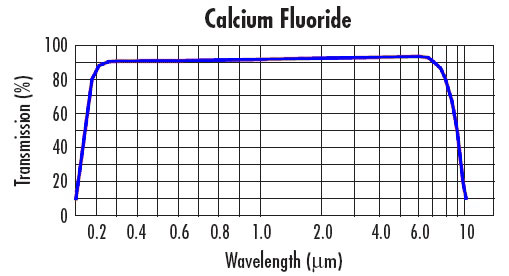CaF2 is commonly used for applications requiring high transmission in the infrared and ultraviolet spectral ranges. Its extremely high laser damage threshold allows it to be used with excimer lasers. The material exhibits a low refractive index, varying from 1.35 to 1.51 within its usage range of 180 nm to 8.0 μm. Calcium fluoride is also fairly chemically inert and offers superior hardness compared to its barium fluoride, magnesium fluoride, and lithium fluoride cousins. Calcium Fluoride has widespread IR applications as spectroscopic CaF2 windows, CaF2 prisms and CaF2 lenses. Especially pure grades of Calcium Fluoride (CaF2) find useful applications in the UV and as UV Excimer laser windows.

| Physical and optical properties of Calcium Fluoride CaF2 | |
| Density, g/cm3 | 3.18 |
| Process | CZ |
| Crystal orientation | 111, 001, 110, 222, 400 |
| Lattice constant(nm) | 0.546342 |
| Color | Colorless |
| Melting point, ℃ | 1420 |
| Transmission range, um | 0.13-10.5 |
| Solubility in water@20℃,g/100 cm3 | 0.0016 |
| Solubility in acids | slightly soluble |
| Solubility in organic solvents: acetone, spirits, ether | insoluble |
| Thermal Conductivity@319K, W/(mxK) | 9.71 |
| Specific Heat Capacity, J/(kgxK) | 854 |
| Thermal Expansion@300K, 10-6/C | 18.5 |
| Young’s Modulus, GPa | 75.8 |
| Shear Modulus(G), GPa | 33.77 |
| Knoop Hardness, kg/mm2 | 158.3 |
| Compressive Modulus K, GPa | 83.8 |
| Poisson’s Ratio | 0.26 |
| Mohs Hardness | 4.0 |
| Refractive Index as a function of wavelength | |||
| Wavelength(um) | Refractive Index | Wavelength(um) | Refractive Index |
| 0.19 | 1.51 | 2.65 | 1.42 |
| 0.20 | 1.50 | 3.90 | 1.41 |
| 0.21 | 1.49 | 5.00 | 1.40 |
| 0.22 | 1.48 | 5.80 | 1.39 |
| 0.25 | 1.47 | 6.20 | 1.38 |
| 0.27 | 1.46 | 6.70 | 1.37 |
| 0.33 | 1.45 | 7.00 | 1.36 |
| 1.41 | 1.44 | 7.50 | 1.35 |
| 2.88 | 1.43 | 8.22 | 1.34 |